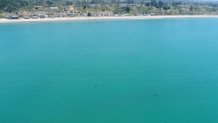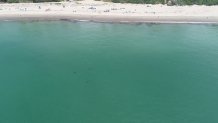Fisherman Eric Mailander saw the flash of gray from the corner of his eye as he fished anchovies off the coast of Santa Cruz in the Monterey Bay. It didn't take but a second to recognize the visitor.
"When I was reeling it up, a shark passed by," Mailander recalled. "Not aggressive but a white shark."
As a veteran fisherman who'd seen plenty of white sharks over the years, the sight struck him as odd. It was a young shark where the Bay Area normally sees only adults. More puzzling, it was outside the Bay Area's typical white shark season between August and February.
"It's like 'whoa!' Mailander said, "what's a little white shark doing in this area?"
Get a weekly recap of the latest San Francisco Bay Area housing news. Sign up for NBC Bay Area’s Housing Deconstructed newsletter.

The encounter set Mailander on a path of observation that would tip scientists to a drastic and unexplainable shift in the Bay Area's white shark population. It turned out young white sharks were venturing into the Monterey Bay for the first time and in a different season, and no one knew why.
"This is an area that never had small white sharks," said UC Santa Cruz researcher Salvador Jorgensen, who has studied the Bay Area's shark population for fifteen years. "This is something that I'd never seen before and couldn't find any records of these small sharks being seen this far north."

The arrival of juvenile white sharks in the Monterey Bay began around 2014 and coincided with several climate events that brought warmer waters to the Bay Area coastline -- including a particularly curious influx of warm ocean water scientists dubbed the "warm blob."
Local
Because juvenile white sharks require a warm core temperature, they're normally located in Baja and warmer waters further South. Jorgensen theorizes the young sharks are following warming waters into the Monterey Bay where they became trapped in small warm pockets as surrounding ocean waters cool. He attributes the phenomenon to changing climate.
"It's exciting to go out there on a day and see 10 little sharks where they never were before," Jorgensen said. "But when you take a step back and think about what's going on, it's alarming."
While adult white sharks can reach up to 18 feet in length, juveniles range between five to 10 feet. And unlike the adults which eat marine mammals, younger sharks prefer fish. Jorgensen sees it as one of the ways climate change can have unexpected impacts on the environment.
"You can imagine how it could change the eco-system here when suddenly you have a new hot spot for all these small sharks that are starting to eat fish," Jorgensen said, "and how that's interacting with protected species like salmon."
Jorgensen doesn't know whether the young white sharks are born in the area, or migrate from somewhere else. He's begun tagging some in an attempt to find out where they go once they leave. Despite the unknowns -- what's firm in his mind -- is their presence is an indicator of vast environmental change.
"I think these little white sharks are really acting as a local sentinel," Jorgensen said, "an early warning for us that really helps us see what climate change is."
Three years ago Mailander invested in a drone, and began to capture footage of dozens of small white sharks swimming off the shores of Santa Cruz, basking just beyond the surf. He said the sharks begin arriving in early April and he routinely sees dozens of them in a single day. His record for sightings is thirty-one sharks, all contained within a 2-mile zone between Sand Dollar Beach and the Cement Ship.

"I started keeping meticulous boat logs," Mailander said. "I started doing that with drone flights. How many I see. Where I see them."
The images of dozens of small white sharks swimming just beyond the surf where people are swimming and surfing raises concern for some. In May of 2020, surfer Ben Kelly, 26 was killed after he was bitten by a juvenile white shark, estimated between ten and twelve feet near Manresa Beach.
Though Jorgensen said many of the sharks observed close to shore are swimming near the surface, indicating they're absorbing sun and not a threat to humans -- he did urge caution.

"When you look out and you're about to go for a swim and you see a few sharks," he said, "you need to think twice before you get into the water."
Mailander, who works as a firefighter in the South Bay, is relishing his gig as a citizen scientist, helping to document the behavioral change in a vastly misunderstood creature, all in the service of science. Where his reward was once catching fish, he now aspires to capture photos of these unique sharks as he navigates his boat through the Monterey Bay.
"The excitement is always there," Mailander said, "it never leaves me."




